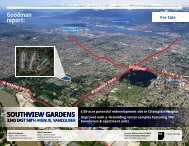Canada
MER-Canada-2016
MER-Canada-2016
You also want an ePaper? Increase the reach of your titles
YUMPU automatically turns print PDFs into web optimized ePapers that Google loves.
CHAPTER 4. TERRORIST FINANCING AND PROLIFERATION FINANCING<br />
4<br />
giving and volunteering. In addition, it looked at existing laws and reporting requirements affecting<br />
NPOs. To determine where there is risk, NPOs were categorized based on shared characteristics<br />
such as purpose, activities, size and location of operation. The CRA compared those characteristics<br />
with the elements of the FATF definition of NPO. It also took into consideration the findings of the<br />
FATF typologies report Risk of Terrorist Abuse in NPOs to identify features that put organizations a<br />
greater risk.<br />
The CRA found that, in <strong>Canada</strong>, the organizations at greatest risk of terrorist abuse are charities. As a<br />
result, the authorities concluded that, in the Canadian context, only charities fall within the FATF<br />
definition of NPO. While organizations at greatest risk are charities, not all charities are at risk. The<br />
insight obtained from the sector review allowed <strong>Canada</strong> to focus on charities as the starting point<br />
for its NRA.<br />
Source: FATF (2015), Best practices paper on combating the abuse of NPOs—October 2015.<br />
188. The registered charity met during the assessment is large and has a number of international<br />
connections. It has a good understanding of its vulnerability to TF and has implemented adequate<br />
measures to mitigate that risk, without disrupting legitimate NPO activities.<br />
Deprivation of TF assets and instrumentalities<br />
189. As of February 2015, the total amount of frozen assets belonging to designated entities is<br />
CAD 131 235 in 12 bank accounts, CAD 29 200 in six life insurance policies, nine house insurance<br />
policies, and one automobile insurance policy, totalling CAD 3 248 612 frozen. The number of<br />
entities that had their assets frozen was not provided.<br />
190. Despite the high number of TF occurrences (see IO.9), no assets and instrumentalities<br />
related to TF were seized or confiscated in circumstances other than designations. There are several<br />
reasonable explanations for this. LEAs indicated that, in several cases, no assets or instrumentalities<br />
were found. In others cases, the lack of confiscation can be due to the fact that TF investigations do<br />
not always result in TF charges and other means of disruption (see IO 9). The authorities also<br />
provided cases of TF investigations unrelated to the UN designations where the RCMP seized some<br />
assets and instrumentalities, 71 but did not proceed to seek their confiscation.<br />
Consistency of measures with overall TF risk profile<br />
191. While the terrorist threat has grown in the recent years, in particular in light of an<br />
increased number of Canadian nationals who have joined terrorist groups abroad, 72 not all terrorist<br />
entities identified have financing or support in <strong>Canada</strong>. In October 2014, <strong>Canada</strong> was victim of two<br />
71 The assets seized included over CAD 10 000 in cash, in one case, and tractor trailers in another.<br />
72 As stated by the Director of CSIS following his appearance at the Senate Committee on National Security and<br />
Defence, as of the end of 2015, the Government was aware of approximately 180 individuals with Canadian a<br />
nexus who were abroad and suspected of engaging in terrorism related activities. The Government was also<br />
aware of a further 60 extremist travellers who had returned to <strong>Canada</strong>.<br />
72<br />
Anti-money laundering and counter-terrorist financing measures in <strong>Canada</strong> - 2016 © FATF and APG 2016




